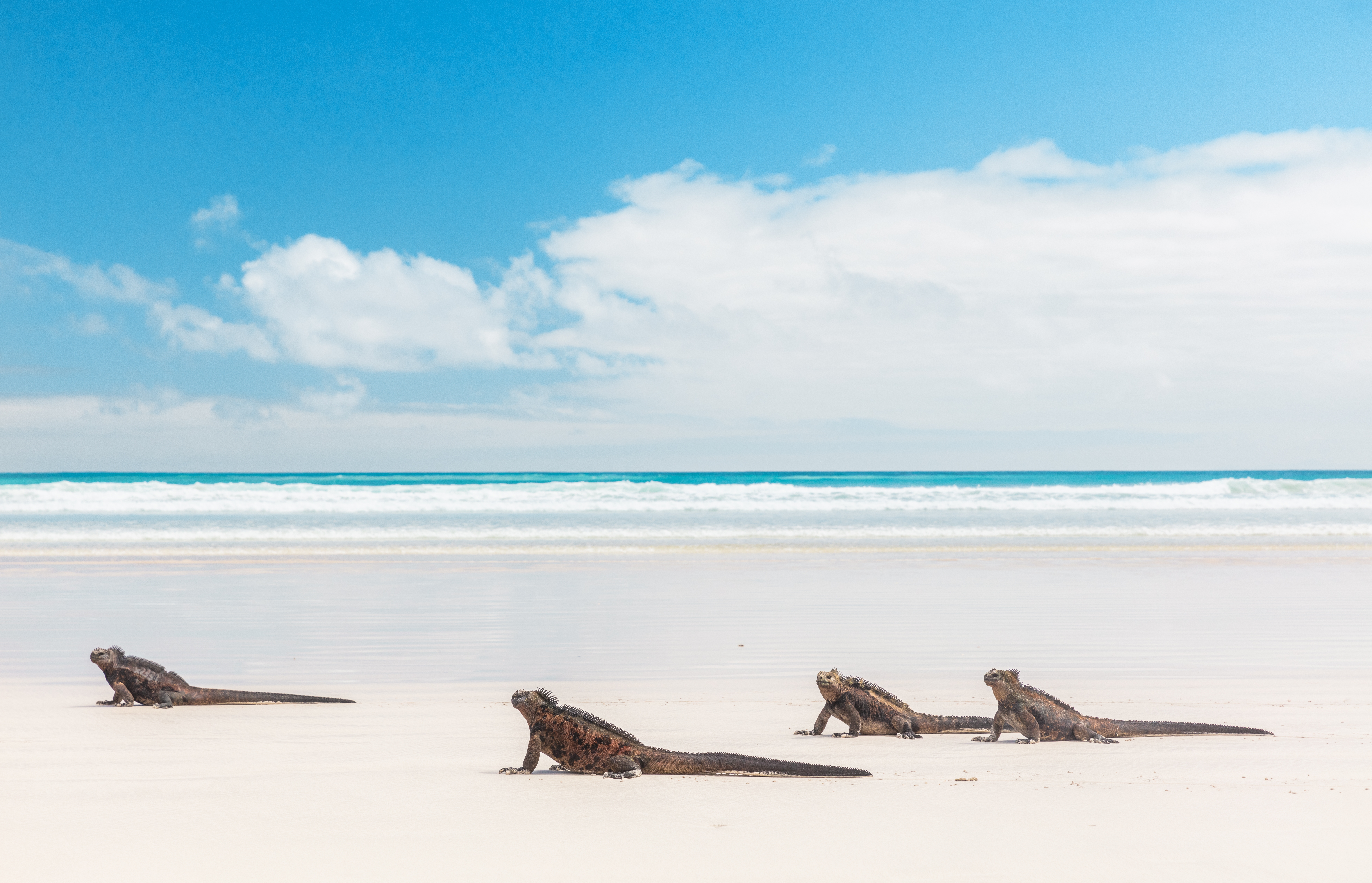Discover one of the most biologically unique destinations on Earth by yacht charter, The Galápagos Islands. Located nearly 1,000 kilometers off the coast of Ecuador, in South America, the Galápagos Islands are a living museum of evolutionary wonders, where time seems to stand still. This volcanic archipelago, made famous by Charles Darwin’s groundbreaking theories, is home to a staggering array of endemic wildlife found nowhere else on the planet — from giant tortoises and marine iguanas to vibrant finches and playful sea lions. A superyacht charter in The Galápagos Islands promises a surprisingly mild climate thanks to the Humboldt and Cromwell ocean currents, making them an ideal year-round yacht charter destination.
DAY 1 | SANTA CRUZ ISLAND TO HOOD ISLAND
Begin your yacht charter journey from Santa Cruz, the second largest and most populous island in the archipelago. Puerto Ayora, the island’s main town, offers well-developed tourist infrastructure and is home to the Charles Darwin Research Station, where efforts to conserve the 11 subspecies of giant Galápagos tortoises are ongoing. At one of the highest points on the island, you can also find the twin volcanic craters of Los Gemelos, surrounded by lush Scalesia forest.
Cruise toward Hood Island (Española), a picturesque destination known for its stunning landscapes and abundance of wildlife. This island is one of the oldest in the archipelago and the only nesting site for the waved albatross, which perform fascinating courtship rituals involving beak fencing and head bobbing. Hood Island’s white sand beaches are favored by sea lions, mockingbirds, marine iguanas, and colorful locusts. Snorkel in the crystal-clear waters or enjoy hiking among dramatic cliffs with sweeping ocean views.
DAY 2 | HOOD ISLAND TO SAN CRISTOBAL
Another must-visit destination during your yacht charter in The Galapagos Islands is San Cristobal. The island is home to the capital of the archipelago, Puerto Baquerizo Moreno, and the only island with an inexhaustible source of freshwater — Laguna El Junco, a volcanic crater lake teeming with birdlife. The island offers diverse terrain from arid zones to lush pampa and is home to giant tortoises, fur seals, blue-footed boobies, gannets, and frigatebirds.
Visit Punta Pitt for some of the best snorkelling, diving, and birdwatching in the Galápagos, or explore by 4WD. Food lovers will appreciate the variety of cuisine in town, ranging from seafood and Ecuadorian to Italian and Middle Eastern. San Cristobal is also one of the few islands where you can see the Galápagos mockingbird and Galápagos finch in the same region.
DAY 3 | SAN CRISTOBAL TO SANTA FE
Santa Fe Island, though small in size, is rich in biodiversity. Only about 24 square kilometers, it is one of the oldest islands in the archipelago. Unique to Santa Fe is the Santa Fe land iguana, distinguishable from other iguana species and often found lounging under giant prickly pear cacti waiting for fruit to fall.
At Barrington Bay, choose between two scenic hikes — one that leads up to a cliffside viewpoint and another through cactus forest. The island teems with life, including lava herons, hawks, sea lions, stingrays, green turtles, and Galápagos doves. Kayaking and snorkelling in the lagoon offer encounters with marine life in a calm and secluded setting.
DAY 4 | SANTA FE to tower island
Tower Island (Genovesa), often referred to as “Bird Island,” is a remote paradise renowned for its extraordinary seabird colonies, including red-footed boobies, storm petrels, and the elusive short-eared owl.
The island’s horseshoe-shaped bay and dramatic cliffs create a striking landscape, perfect for hiking and photography. Keep your eyes open for magnificent frigatebirds with their striking red throat pouches and Galápagos finches darting between shrubs. The snorkelling here is also phenomenal, often with rays and reef sharks cruising by below.
DAY 5 | TOWER ISLAND TO SANTIAGO ISLAND
Uninhabited Santiago Island is an ecological work in progress. Efforts are currently underway to control the population of invasive species like goats, pigs, and rodents, which once disrupted the fragile ecosystem.
Explore the lava fields and coastal rock formations, where you might encounter Sally Lightfoot crabs, octopuses, and sea turtles, and swim among rays and schools of tropical fish at Puerto Egas. Inland hikes offer the chance to spot Galápagos hawks, fur seals, and lava lizards, while natural rock bridges provide a dramatic backdrop to your trek.
DAY 6 | SANTIAGO ISLAND TO RABIDA ISLAND
Rabida Island is striking for its deep red sands, the result of high iron content in its volcanic rocks. This uninhabited island offers an intimate visitor experience. Upon arrival, you will be greeted by a welcoming party of sea lions lounging along the beach.
A gentle hike leads to a cliff viewpoint perfect for panoramic photography, while snorkelling here often brings encounters with reef sharks, rays, and vibrant fish. Rabida is also one of the best places to photograph pink flamingos feeding in the brackish lagoon, as well as pelicans and Galápagos penguins nearby.
DAY 7 | RABIDA ISLAND TO BALTRA
Also known as South Seymour Island, Baltra Island is not within the borders of the Galapagos National Park. The island is home to the second airport in the Galapagos, the other being on San Cristobal Island.
The island itself is relatively flat and arid but offers scenic hikes where you may spot native birds like frigatebirds and lava gulls. From here, you will disembark with memories of an extraordinary journey through one of the world’s last true natural sanctuaries — a place where wildlife reigns, and evolution continues to unfold before your eyes.







